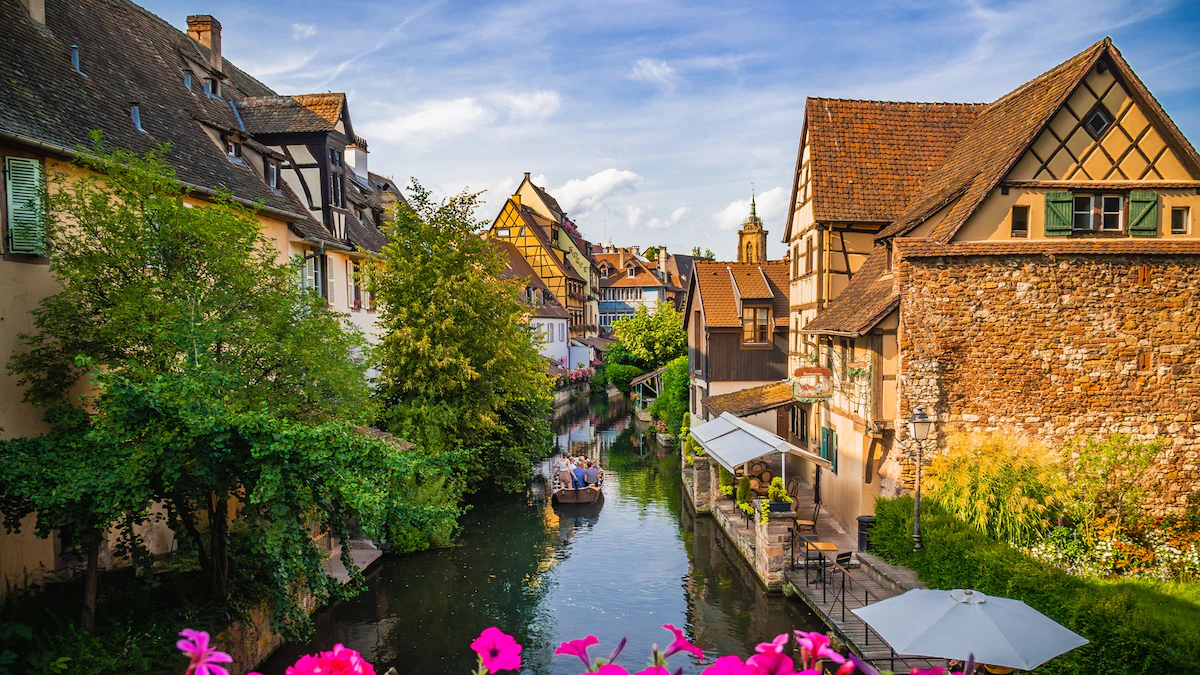
Alsace—now formally known as Grand Est—is part of northeastern France, though it owes much of its cultural heritage to Germany. The neighboring countries have volleyed the region back and forth between wars, treaties, and the redrawing of maps for hundreds of years. That mingling of binational influences comes to life in Colmar.
Half-timbered houses line the canals, evoking the gingerbread manse of childhood storybooks. Cozy winstub (traditional, homestyle Alsatian restaurants) serve choucroute garnie (an Alsatian recipe with sauerkraut and various pork parts) and baeckeoffe (meat and potato stew). And you’re never more than a few minutes from a glass of riesling, whether that’s at a bottle shop, bar, or local winery.
It’s a city with a walkable, small-town feel and an out-sized amount of charm—especially during the holidays, when the smell of vin chaud and cider wafts out of the bustling Christmas markets and decorations adorn the fairytale facades. Beyond the merriment of December, spring and summer buzz with the excitement of blooming flowers, warmer weather, and seasonal events, such as the Alsace Wine Festival, which kicks off in late July. Fall is particularly photogenic with the changing leaves and fewer crowds.
(These under-the-radar French Riviera towns offer quiet charm)
Day 1: Walking tours and winstubs
Morning
Start the day with a coffee and a pastry at Omnino, a local micro-roastery and specialty coffee shop chain with locations in Colmar, Strasbourg, and Mulhouse. Once caffeinated and sated, it’s time to explore Colmar Old, a postcard of cobblestone streets, colorful half-timbered houses adorned with flower boxes, and scenic canals. The historic district is a well-preserved gem, where visitors can admire the distinctive architecture, compact winstubs, and local shops. While you could happily trot along for hours, peering around corners and down narrow alleys, the best way to learn about the city’s Franco-German identity, past and present, is on a guided walking tour through La Petite Venise.
Afternoon
When hunger hits, it’s off to an authentic winstub. Quick etymology lesson: winstub comes from the German word weinstube—typical taverns where winemakers offloaded their surplus and had a hearty meal. More than just a place to eat and drink—though, of course, that’s the primary purpose—winstub are a cozy cornerstone of Alsatian culture where people come together over tarte flambée and local wine. Wistub de la Petite Venise is a favorite for digging into classic Alsatian dishes in a warm, cozy setting. Save room for Linzer tarte for dessert.
With a full stomach, it’s off to sip the region’s most prized product. Colmar is a key point on the Alsatian Wine Route. It’s surrounded by renowned wine-producing areas, including Grand Cru vineyards and family-run estates, including Meyer-Fonné in Katzenthal where care and craftsmanship are passed down through generations. Don’t feel like driving? Walk over to Musée des vins d’Alsace à Colmar to learn about the fascinating history of Alsace wine, meet local winegrowers, and, of course, to sample a few glasses.
Evening
As the afternoon creeps toward evening, journey back into town to sip your way through a couple of local wine bars. Au Temps d’un Verre is a great first stop because the self-service dispensers allow budding oenophiles to sample a variety of wines available in both full glasses and smaller tasting pours. Continue on to Sainte Joie’s beautifully restored stone-clad tasting room on Rue de Reiset. For an elevated twist on a traditional winstub, La Brasserie Historique, located in the 17th-century La Maison des Têtes, is superb. Meals start with pretzels and end with a cheese course, followed by a decadent dessert (order the chocolate soufflé). In between, it’s a smorgasbord of foie gras, tarte flambée with black pudding and apples, and choucroute garnie.
Day 2: Canal cruises, covered markets, and museums
Morning
Start the day slowly. Wake up at your leisure and meander over to La Bonneterie. It’s the perfect spot for coffee and brunch fare (the pancakes with seasonal fruit are always a crowd pleaser) and also puts you steps from the canals. Colmar is often referred to as “Little Venice” or the “Venice of France” due to its picturesque canals. A boat ride along the waterways ranks among the most scenic and pleasant ways to see the city. After having grounded your understanding of the city’s history courtesy of a guided walking tour, floating along the waterways provides a different vantage point to admire history on display.
Afternoon
Food is such an important part of Alsatian culture. Travelers in search of local products will find plenty of meat, cheese, fruits, vegetables, and pretzels at Le Marché Couvert de Colmar, dating back to 1865. Should your palate need a reprieve from heavier Alsatian food, the market hall also houses vendors selling Vietnamese spring rolls, vegan burgers, vegetable-forward soup, and pizza.
Fans of art won’t want to pass up the chance to visit Musée Unterlinden. Housed in a former Dominican convent dating back to the 13th century, it’s one of the region’s most renowned museums with a collection spanning from the Middle Ages to contemporary works. It’s best known for the “Isenheim Altarpiece,” a masterpiece of Renaissance art by Nikolaus Haguenaur and Matthias Grünewald. The museum also features an impressive selection of Alsatian folk art, sculptures, and paintings by prominent artists such as Picasso and Monet.
Next up: The Village of Hansi and its Museum, which celebrates the life and work of artist Jean-Jacques Waltz, nicknamed Hansi. Be sure to stop by the first-floor shop (it’s impossible to miss) to browse the selection of cookies, home decor, Christmas ornaments, and tea towels.
Evening
For a truly exceptional meal, make a reservation at JY’S (short for Jean-Yves Schillinger, the Michelin-starred chef at the helm). The fine-dining destination on the Champ de Mars park offers diners an exceptional gourmet experience that marries local ingredients, global flavors, and silver service. Opt for the six-course tasting menu; there’s also a supplemental wine pairing. Fancy a nightcap? Wander over to Le Major’L for a glass or two of local wine. If you’re wondering whether to order a post-dinner meat and cheese board, the answer is always yes. Take one last postcard-worthy stroll along the canals before calling it a night.
(Where do French presidents unwind? This stunning medieval fortress.)
Three great day (or afternoon) trips from Colmar
1.Riquewihr
If you haven’t had your fill of local vin, consider a quick trip to Riquewihr, a 20-minute drive from Colmar. Called one of the most beautiful places in France, the medieval village on the Alsace Wine Route is chock-full of storybook Alsatian character: Cobbled streets, pastel-hued half-timbered buildings, quaint wine shops, and ringing church bells. In the verdant countryside just outside of town are beloved Grand Cru vineyards, such as Schoenenbourg, one of the best-known producers of riesling and gewürztraminer.
2.Eguisheim
A short drive or scenic bike ride from Colmar, Eguisheim, set on the Alsace Wine Route, is another ideal destination for oenophiles to experience the rich heritage and flavors of Alsace. Start at the family-run Domaine Joseph Gruss & Fils for well-balanced white wines like gewürztraminer, riesling, pinot gris, and sylvaner, plus Cremant d’Alsace sparkling. Go to Vignoble des 3 Terres – Domaine MANN for the terroir-driven pours, stay for the vineyard photo ops (or vice versa.) Of course, the charms of this enchanting Alsatian village aren’t limited to what’s in the bottle or glass; a stroll around the winding streets puts travelers face to face with colorful timber-framed facades and medieval churches.
3.Strasbourg
Alsace is peppered with winsome small towns, worthy of a visit. Though that doesn’t mean you should skip its largest city. Strasbourg, the regional capital, located a 25-minute direct train from Colmar, might not have the village-like qualities of some of its neighbors, but it’s an unforgettable destination for culture and cuisine. A place where wine and beer are of equal import (a sippable reminder of its French and German influence), the picturesque La Petite France district brims with canal-side bars. The famous Cathédrale Notre-Dame-de-Strasbourg, a symbol of the city, commands attention with its ornate Gothic facade, constructed from pink sandstone from the Vosges Mountains.
How to do it
There’s a direct TGV, or Train à Grande Vitesse, high-speed train from Paris to Colmar. It’s a two-and-a-half-hour ride from Paris Gare de l’Est to Colmar Place de la Gare, and then a short walk to the center of town. Stay at La Maison des Têtes, a Relais & Châteaux hotel tucked inside a landmark 17th-century building.



